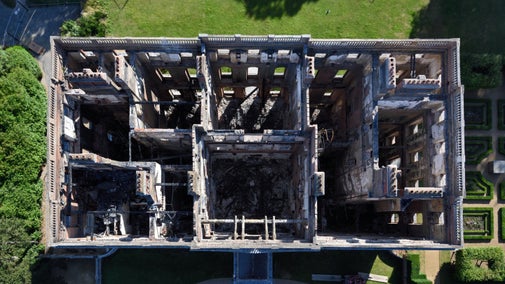
A new future for Hinemihi
We've agreed in principle with Heritage New Zealand to return Hinemihi, the 19th-century Māori meeting house at Clandon Park in Surrey, to her ancestral home in New Zealand.

Hinemihi o te Ao Tawhito (meaning ‘Hinemihi of the old world’) is a 19th-century Māori meeting house, brought from New Zealand to England by the 4th Earl of Onslow, William Hillier, in 1892. From surviving a volcanic eruption to becoming an important part of Māori culture in the UK, discover Hinemihi’s journey.
Hinemihi’s construction began in 1880 in the small settlement of Te Wairoa, located in a volcanic region of New Zealand’s North Island. The settlement was an established tourism centre, where visitors would come to experience Māori culture.
Commissioned by Chief Aporo Wharekaniwha, head of the Ngāti Hinemihi sub-tribe, she was created to fill the traditional roles of a meeting house where issues were discussed, births and marriages were confirmed and the dead mourned, alongside being used to entertain tourists interested in cultural performances.
Few Māori meeting houses bear female names but Aporo chose to name Hinemihi after a noted female ancestor, famous in legend for keeping the company of a giant lizard.
Two carvers, Wero Taroi and Tene Waitere, were commissioned by Aporo to build Hinemihi from local totara wood. Both men are now regarded as being among the great Māori carvers of their time.
Their carvings represent ancestors from tribal history and by including them in the meeting house, they provided a place where the spirits of these ancestors could dwell and protect their descendants.
As a gesture towards his status and wealth, Aporo added a final flourish to Hinemihi. Instead of using traditional paua shells to depict eyes on the carved figures, he attached gold sovereigns. Upon its completion in March 1881, Aporo named his new meeting house ‘Hinemihi of the old world.’ To locals and visitors, she became known as ‘Hinemihi of the golden eyes.’

On 10 June 1886, nearby Mt. Tarawera erupted without warning, raining magma and ash down on Te Wairoa. The eruption claimed the lives of 153 people. A fortunate few found shelter in Hinemihi and survived through the night; among them was the young carver Tene Waitere and his family.
The scale of the devastation forced the remaining population of Te Wairoa to leave their homes. The Ngāti Hinemihi people re-settled in nearby Rotorua, which was largely undamaged by the eruption.
By 1891 William Hillier, 4th Earl of Onslow, was approaching the end of his term as Governor of New Zealand and wanted to take home a reminder of the country he loved.
A sum of £50 was agreed by the son of Chief Aporo, Mika, to purchase Hinemihi. An official hand-written bill of sale was drawn up and dated 27 January 1892. Easily dismantled and moved, Hinemihi’s carvings were shipped to England, although some were missing.

Originally her carvings were installed onto a new structure created in the grounds of Clandon Park, next to an ornamental lake. Historical accounts describe how she was moved to her present site during the First World War by soldiers from New Zealand, including Māori troops recovering at Clandon during its time as a military hospital.
By the time Clandon Park was donated to the National Trust in 1956, Hinemihi was in need of repair. In the 1960s we approached New Zealand’s High Commission for help with a restoration programme, and other partners from New Zealand made financial contributions, along with a supply of totara wood, which is traditionally used.
Further repairs were undertaken in 1979 by an English firm specialising in the restoration of historic wooden buildings. They had little visual material to copy other than an old photograph of Hinemihi taken a few days after the eruption, with her roof covered in volcanic debris. Innocently mistaking several tons of rooftop ash for traditional English thatch, they replaced the roof with a thick covering of Norfolk reeds.
- Emily Schuster, descendent of carver Tene Waitere, who visited Hinemihi in 1986
By 1992, Hinemihi had stood in the grounds of Clandon Park for a century. The anniversary was marked by a visit from John Marsh, director of the New Zealand Māori Arts and Crafts Institute.
Back in New Zealand, Marsh thought about restoring Hinemihi’s missing carvings. He appointed two students from the institute to create new pieces. They were Robert Rika, fourth generation grandson of carver Tene Waitere, and Colin Tihi, third generation grandson of Chief Aporo.
They agreed to produce the work from detailed images taken by Victorian photographer Alfred Burton on a visit to Te Wairoa in 1881.
The new carvings were officially handed over at dawn on 9 June 1995, almost 109 years since Mt Terawera’s eruption. The arrival of the new carvings, and the ceremony to accept them, created a new profile for Hinemihi, who became the adopted meeting house of London’s Māori community - a place to visit, remember ancestors and celebrate their culture.

We've agreed in principle with Heritage New Zealand to return Hinemihi, the 19th-century Māori meeting house at Clandon Park in Surrey, to her ancestral home in New Zealand.
Clandon Park has a number of direct connections to slavery and colonialism. Understanding these links is an important part of our work.

Read our report on colonialism and historic slavery in the places and collections we care for and discover how we’re changing the way we approach these issues.

Clandon Park's history spans more than three centuries, from its origins as a grand Georgian home to its time as a First World War military hospital and subsequent restoration in the 1960s.

The Onslow family first moved into Clandon Park in 1641 and since then there have been record-breaking politicians, First World War workers and pioneering women.

Curator Sophie Chessum witnessed the fire at Clandon Park first-hand. Read her account of the night of 29 April 2015.

Take a look at our timeline to find out what the team have been working on.